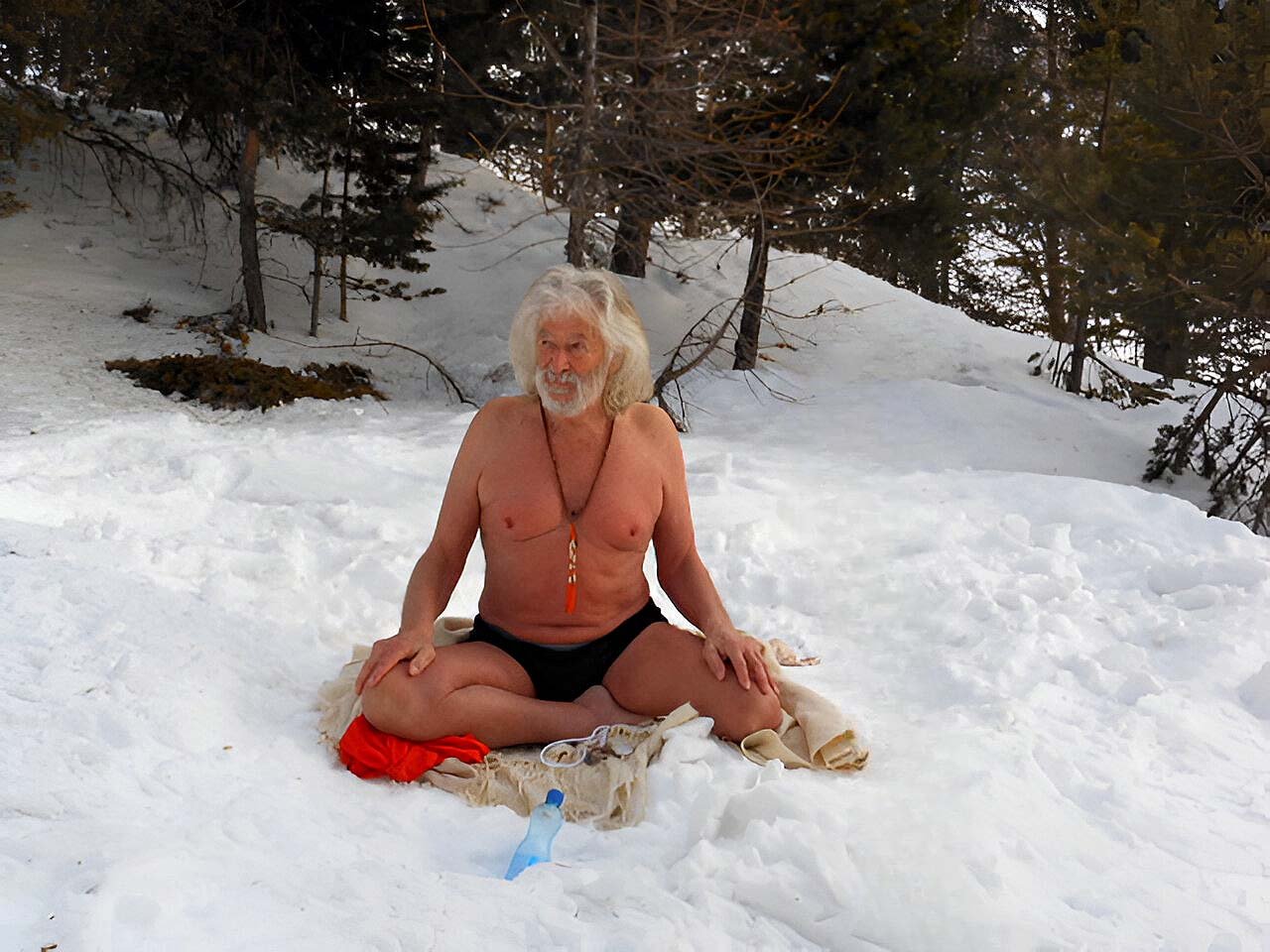Tummo Yoga
Science
What science says
Author : Dr Anne Laurençon
Adapting to the cold
By way of introduction to this page, a quick reminder of what we imagine human beings were like 400,000 years ago: there was no fire to keep warm, so it was the body itself that produced the heat: the subcutaneous layer of fat had to be thick in the cold season. The impact of the cold on our physiology, and more specifically on our metabolism and immune responses, has been described by several scientific studies. By virtue of our heritage, our bodies have several ways of responding to exposure to the cold.
An outsider’s view of Tibetan tantric practices is bound to focus on one of its six fundamental practices: toumo. Practitioners expose themselves to the cold for long periods without any outward sign of distress. As if that weren’t enough, they can dry wet pieces of cloth on their shoulders in sub-zero temperatures… These practices effectively result in an adaptation to the cold that is merely a secondary effect for the adept: he is practising a technique aimed at the human psyche. Toumo is traditionally taught as a way of experiencing “the transfer of consciousness to a lifeless body, followed by its rebirth” (Je Tsongkhapa, initiator of the Gelug school). At the present stage of its development, science has no conceptual framework for testing this type of assertion, but it can take an objective interest in what happens to body heat.
THE BODY IN THE FACE OF EXPOSURE TO COLD
Several studies support the consequences and benefits of voluntary exposure to cold, and cover all types of exposure. Whether it’s swimming in ice-cold water, bathing in cold water after physical effort or other practices such as cryotherapy, hot/cold contrast therapy… So I’m not trying to go into detail here, but just to give the broad outlines of what has been described to date by the various schools of physiologists, with references to full articles on the various points mentioned for those who are interested.
-
- Brain: exposure to cold releases noradrenaline into the blood, which in the central nervous system plays important roles in attention, vigilance, emotions, sleep, dreaming, nightmares and learning.
-
- Immune and inflammatory system: here noradrenaline will calm the inflammatory state of tissues, and we will see that this is linked to adipose tissue. This action is therefore predicted to be the driving force behind improvements in certain cases of arthritis, for example. The improvement of other conditions linked to autoimmune dysregulation is also envisaged: the mechanisms at work are partially described, and many questions remain.
- Metabolism: The major upheaval following exposure to cold is, of course, vasoconstriction: blood withdraws from peripheral tissues. There is also an increase in thermogenesis, i.e. an increase in the production of body heat: this brings into play various regulatory loops that will involve a profound change in our metabolism to produce heat. Here we need to explain that the body has different types of reserves, including adipose tissue, which contains fat. White fats can be released to provide energy, but they take a long time to break down, passing through the liver. Brown or beige fats, on the other hand, are used locally and can therefore warm tissues where they are stored: these stocks are built up by people who are exposed to the cold. Adipose tissue releases a broad spectrum of molecules that control insulin sensitivity and inflammatory processes.
I will mention here two publications published in 2014 which enable us to put into perspective how the body reacts in practices close to what the Tibetans practise in toumo. The first study, published in 2014 in collaboration with American and Russian researchers, also provides an insight into the physiological changes at work. The second study looks at the practices developed by Wim Hof. I am interested here in a publication which is in my eyes by far the most interesting because it focuses on novices practising the method he proposes, and therefore shows the physiological changes that can take place without being an exceptional man (as Maurice Daubard or Wim Hof are).
-
- Minvaleev and colleagues are interested in blood changes on practitioners in outdoor conditions, in the Himalayas. They show that blood circulation criteria are increased and postulate that the practice of breathing used massively increases sympathetic activity with activation of adipose tissue (beige) and that this is directly linked to heat production.
- Professor Pickkers’ team (Nijmegen, Holland), describes in an article published in a prestigious journal the action that each Man can have on his sympathetic system. This nervous system is supposed to be autonomous, i.e. to operate automatically: here the volunteers taking part in the study show that they can trigger its activation. After ten days’ practice of meditation and breathing as presented by WH, these people, and a control group who practised a different physical activity at the same time, were tested. The team injected them with a toxic protein that triggers an immune reaction: the reaction of the control group is clearly present, whereas for the group practising, the pro-inflammatory proteins are less expressed and their noradrenaline level is higher; their response to this injection is less (no cold symptoms).
These studies have several implications: for the work led by Minvaleev, breathing must be considered the body’s major thermal regulator. For him, the heat given off by the muscles (in simple activity or by shivering) is not enough to explain the heat that a practitioner gives off during yogic practices. For the Picckers group, the possibility of being able to act on persistent conditions of inflammation and also autoimmune diseases is emerging and needs to be studied further.
Studies dedicated specifically to Tummo Yoga
Among the various articles available, the work most closely related to Toumo practitioners is produced by Herbert Benson’s laboratory (Harvard, USA). An additional study, published in 2013, refines the observations made in this pioneering work.
-
- In the 1980s, H. Benson’s team gained access to Tibetan monks to study their body temperature during tummo practices. This work was published in 1982 in a prestigious journal where the authors speak of a maximum described increase of 8°C on the fingers and toes of practitioners during meditative phases. A collaborative study published in 2013 followed, and focused on Tibetan nuns and monks: the recordings made were more comprehensive, and the protocol also enabled physiological changes to be better understood. The measurements of changes in the temperature of the extremities observed reproduce the variations during the practices (smaller but present). In addition, they observed an increase in body temperature: this is directly linked to the lung’s retention capacity, which for some practitioners is impressive (2’50”!!!).
- This study also looked at a group of martial arts or yoga practitioners who applied equivalent protocols (breathing techniques used by the Tibetan group, and equivalent durations). Although the increase in body temperature in this group is more modest, it is definitely present. It is also worth noting that, unlike the Tibetans, the return to basal temperature is faster when the practice is stopped. To sum up, the study concludes that non-practitioners can indeed learn to modulate their body temperature by applying breathing techniques.
These studies have several implications: on the one hand, the temporal increase reported by the different groups of exercisers. Secondly, the hypotheses that the researchers put forward in connection with their research. For Benson, there is a relaxation response in the body which is a physiological state opposite to the physiological state of stress. He uses this conceptual framework to train patients to use this relaxation response in the face of intrusive negative stress-related thoughts that plague them. He hopes that these techniques will be used to help alleviate physical and mental suffering.
In Kozhenikov’s work, two of the factors measured can be predicted by the increase in body temperature during practice: retention time, as we have seen, and the use of mental imagery during the meditative phases. The authors therefore suggest that the attention paid to the inner state during these practices is a key element that should not be neglected: it is difficult to develop this attention, developed during sitting practices, in dynamic body practices.
As for Maurice Daubard, he has been followed by teams of scientists on several occasions, for example in 2007 during his expedition to Finland.

The Master


